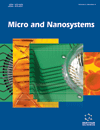
Full text loading...

Nanosponges as a drug delivery system are solid, nanoporous structures that have a unique ability to form complexes with different types of hydrophilic and hydrophobic drug moieties that aid in drug solubility. Cilnidipine is a dihydropyridine N- and L-type calcium channel blocker used to treat hypertension. The drug belongs to BCS Class II, showing low aqueous solubility and hence requires a proper drug delivery system for enhanced therapeutic action. Nanosponges will act as an excellent drug delivery carrier to overcome such challenges. The aim is to formulate and evaluate the cilnidipine-encapsulated nano sponges for oral delivery. The study aims to enhance the solubility and control the dissolution of Cilnidipine using polyvinyl alcohol and ethyl cellulose as polymers.
Four batches of Cilnidipine nanosponges (F1-F4) were prepared using the emulsion solvent diffusion technique. The developed nanosponges were evaluated using FTIR spectroscopy analysis, DSC studies, PDI, particle size measurement, particle shape and morphological analysis, ZP determination, % yield, % EE, % DL, solubility studies, and in-vitro release studies.
The formulations’ mean particle size and zeta potential were found in the range of 212.5 - 416.1 nm and (-26.1) - (-20.8) mV, respectively. The SEM analysis confirmed the presence of spongy, irregularly shaped nanosponges with a porous surface. The results of all the evaluation parameters suggested that F1 was the best fit for all four formulations. F1 exhibited the maximum solubilization efficiency in different media, followed by F2, F3, and F4, respectively. The FTIR analysis of the F1 batch shows no significant interaction with Cilnidipine and excipients. The DSC study revealed that Cilnidipine exhibits a steep endothermic peak at 110.41°C, similar to the Cilnidipine melting temperature. In contrast, the DSC curve of the optimum formulation shows a peak at 200.65°C, which signifies the formation of an inclusion complex. The in-vitro study shows that 81.2% of the drug release was found from the optimized batch (F1). Furthermore, the release from F2, F3, & F4 was found to be 77.67, 71.96, and 58.55% respectively, whereas the drug release of the drug cilnidipine was found to be 43.04%.
The study successfully prepared and evaluated the cilnidipine-encapsulated nanosponges, aiming to enhance the solubility and in vitro profile. The optimized batch (F1) shows an excellent particle size and stability. The SEM analysis ensures the spongy and porous morphology, which contributes to enhancing the drug release. The DSC and FTIR analyses confirm the successful encapsulation of cilnidipine drug within the nanosponges with no interaction between the drug and excipient. The in vitro release study of F1 demonstrates cumulative drug release of up to 81.2%, which is comparatively higher than that of the pure drug, i.e., 43.04%, showing the potential of the nanosponge system to overcome solubility-related limitations of poorly water-soluble drugs.
The cilnidipine-encapsulated nanosponges were successfully formulated using the emulsion solvent diffusion technique. Optimized batch F1 showed the most stabilized average particle size (-26.1mV, 212.5 nm) with maximum entrapment efficiency (83.06%). The SEM analysis revealed an irregular shape and spongy structure with a porous surface, which improved the solubilization efficiency and drug release. F1 exhibits the highest solubilization and drug release (81.2%), outperforming other batches (F2, F3, F4), making it an optimal formulation.

Article metrics loading...

Full text loading...
References


Data & Media loading...